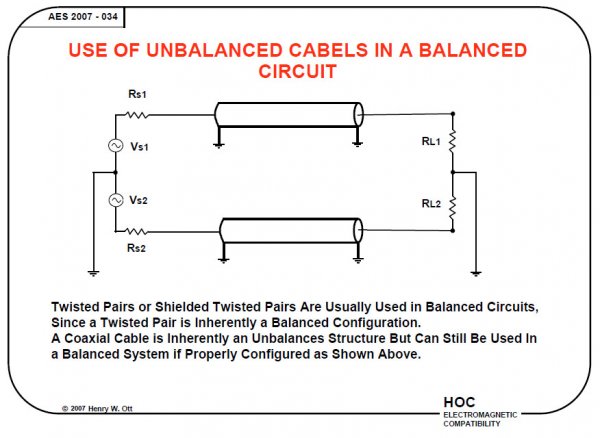I asked the manufacturer why not and he advised that balanced has the effect of canceling out even order distortion but leaving the odd order harmonics. More gain of course, but a thinner, less bloomy sound. This is, I am told, the result of electrical theory well beyond my pay grade. For that reason, he opted for single ended only.
Is there any consensus on this issue? Is balanced properly left to long microphone runs with single ended the right choice for home stereo?
It does not matter the length of the cable- if true balanced the performance is always better than single-ended. It is true that internally balanced circuits will cancel out even ordered harmonic distortion, leaving the odds. However, the odds alway operate at a lower level then the evens, for example the 3rd (being the only odd order that has a musical sound to the human ear) is considerably lower level than the 2nd might have been were it still present, and its presence nevertheless masks the higher orders that are at even lower levels.
Even ordered harmonics (the 2nd in particular) will make for a more lush sound (warmth) but will also mask lower level detail. Its a good idea to get rid of it if you can.
Of course, this being high end audio, there is no consensus

But if you want to understand how well balanced operation really works, you need look no further than your own recording collection. Any recording made in the 1950s or 1960s was done with balanced lines, long before any exotic interconnect cable industry existed, yet the better you get your stereo to perform the better these recordings (many of which are highly respected 50 years on) sound as well. You don't run into some sort of ceiling because you start hearing the defects in the cables used back then.
The whole point of the balanced line system was to eliminate cable artifact. Now you would think audiophiles would love to do just exactly that, but a surprising amount come up with some considerable push-back, but I suspect it is mostly because they don't understand how the balanced system works and the benefits that are thus derived. This is true of a lot of manufacturers too!
The benefits, if done right:
1) ZERO cable interaction, and you can run the cables almost any length. This allows you to place the amplifiers right by your speakers, and have your preamp somewhere else than right between the speakers, perhaps near your listening chair.
2) lower noise, blacker background, less likelihood of ground loops
3) inexpensive cables can be used with world-class results
If equipment is internally balanced the benefits are:
1) lower noise, up to 6db less per stage of gain
2) lower distortion, which does not compound from stage to stage within the circuit
3) greater immunity to power supply noise
Disadvantages
Balanced equipment *might* cost a little more. In high end audio, due to the Veblen effect, this tends to not play out in practice.
You may have noticed That I said 'done right' above. There is a balanced standard of sorts, a set of practices that should be followed if you are to realize all the benefits. Here is the standard:
1) pin 1 is ground, pins 2 and 3 are signal, pin 2 being 180 degrees out of phase with pin 3. In the US, pin 2 is non-inverting.
2) the ground connection is ignored. Neither the input of the preamp/amp uses it, nor the output- it is for shielding only, no signal current. This, BTW, is where most high end companies screw up; by putting ground current through the shield, cable immunity is lost.
3) the input that is being driven should be low impedance (600 ohms is the line level standard), failing that the source should be able to drive that load anyway. Again, most high end companies fail in this regard as well- there are a lot of tube balanced preamps that can't even drive 10K ohms, let alone 600 ohms. BTW, all magnetic/moving coil cartridges and all tape heads are balanced sources and are capable of driving some lower impedances that would choke most tube preamps! If some aspect of this low impedance issue is not utilized, cable immunity will be lost.
4) the balanced connection shall consist of a twisted pair of wires to carry the signal, which is shielded by a common shield. No dual-shielded wires (unless the second shield is concentric around the first), no weird ground boxes, so situations where the non-inverted signal is shielded by the inverted signal, etc.
As a footnote, differential and balanced are not the same thing. It is best when the two are found together. However it is possible for a circuit to be balanced and not differential (such circuits tend to have more noise and higher parts count) and it is also possible to have differential operation without balanced operation. In fact all single-ended amplifiers are examples of the latter, although the differential aspect is usually ignored by the designers of such circuits.
There are lots of balanced products in the marketplace and I don't ever remember reading a review that contained measurements which indicated all even order harmonics had been canceled out and only odd order harmonics remained. Seems like this would really be an issue if true depending on the level of harmonics contained in the signal.
mep, if you recall reading about almost any push-pull amplifier, you might recall reading that even ordered distortions are canceled in the output section, for example this happens in a Dynaco ST-70. The harmonics of the original signal however are left intact.



















